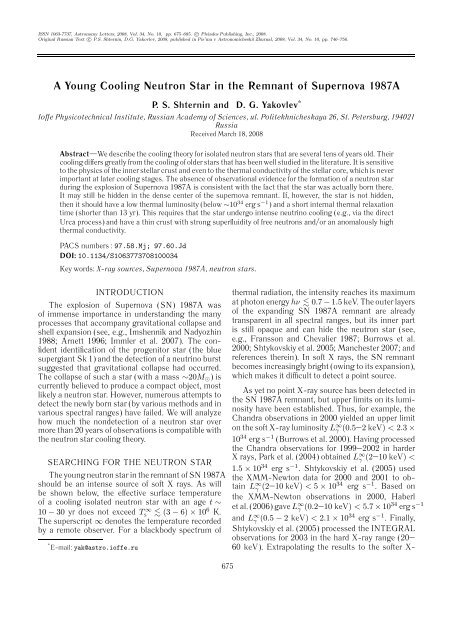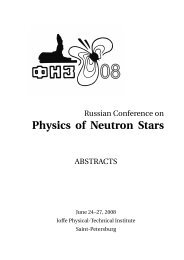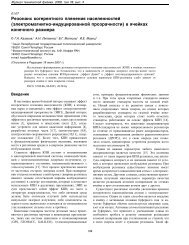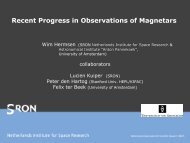A Young Cooling Neutron Star in the Remnant of Supernova 1987A
A Young Cooling Neutron Star in the Remnant of Supernova 1987A
A Young Cooling Neutron Star in the Remnant of Supernova 1987A
Create successful ePaper yourself
Turn your PDF publications into a flip-book with our unique Google optimized e-Paper software.
ISSN 1063-7737, Astronomy Letters, 2008, Vol. 34, No. 10, pp. 675–685. c○ Pleiades Publish<strong>in</strong>g, Inc., 2008.Orig<strong>in</strong>al Russian Text c○ P.S. Shtern<strong>in</strong>, D.G. Yakovlev, 2008, published <strong>in</strong> Pis’ma v Astronomicheskiĭ Zhurnal, 2008, Vol. 34, No. 10, pp. 746–756.A <strong>Young</strong> <strong>Cool<strong>in</strong>g</strong> <strong>Neutron</strong> <strong>Star</strong> <strong>in</strong> <strong>the</strong> <strong>Remnant</strong> <strong>of</strong> <strong>Supernova</strong> <strong>1987A</strong>P. S. Shtern<strong>in</strong> and D. G. Yakovlev *I<strong>of</strong>fe Physicotechnical Institute, Russian Academy <strong>of</strong> Sciences, ul. Politekhnicheskaya 26, St. Petersburg, 194021RussiaReceived March 18, 2008Abstract—We describe <strong>the</strong> cool<strong>in</strong>g <strong>the</strong>ory for isolated neutron stars that are several tens <strong>of</strong> years old. Theircool<strong>in</strong>g differs greatly from <strong>the</strong> cool<strong>in</strong>g <strong>of</strong> older stars that has been well studied <strong>in</strong> <strong>the</strong> literature. It is sensitiveto <strong>the</strong> physics <strong>of</strong> <strong>the</strong> <strong>in</strong>ner stellar crust and even to <strong>the</strong> <strong>the</strong>rmal conductivity <strong>of</strong> <strong>the</strong> stellar core, which is neverimportant at later cool<strong>in</strong>g stages. The absence <strong>of</strong> observational evidence for <strong>the</strong> formation <strong>of</strong> a neutron stardur<strong>in</strong>g <strong>the</strong> explosion <strong>of</strong> <strong>Supernova</strong> <strong>1987A</strong> is consistent with <strong>the</strong> fact that <strong>the</strong> star was actually born <strong>the</strong>re.It may still be hidden <strong>in</strong> <strong>the</strong> dense center <strong>of</strong> <strong>the</strong> supernova remnant. If, however, <strong>the</strong> star is not hidden,<strong>the</strong>n it should have a low <strong>the</strong>rmal lum<strong>in</strong>osity (below ∼10 34 erg s −1 ) and a short <strong>in</strong>ternal <strong>the</strong>rmal relaxationtime (shorter than 13 yr). This requires that <strong>the</strong> star undergo <strong>in</strong>tense neutr<strong>in</strong>o cool<strong>in</strong>g (e.g., via <strong>the</strong> directUrca process) and have a th<strong>in</strong> crust with strong superfluidity <strong>of</strong> free neutrons and/or an anomalously high<strong>the</strong>rmal conductivity.PACS numbers : 97.58.Mj; 97.60.JdDOI: 10.1134/S1063773708100034Key words: X-ray sources, <strong>Supernova</strong> <strong>1987A</strong>, neutron stars.INTRODUCTIONThe explosion <strong>of</strong> <strong>Supernova</strong> (SN) <strong>1987A</strong> was<strong>of</strong> immense importance <strong>in</strong> understand<strong>in</strong>g <strong>the</strong> manyprocesses that accompany gravitational collapse andshell expansion (see, e.g., Imshennik and Nadyozh<strong>in</strong>1988; Arnett 1996; Immler et al. 2007). The confidentidentification <strong>of</strong> <strong>the</strong> progenitor star (<strong>the</strong> bluesupergiant Sk 1) and <strong>the</strong> detection <strong>of</strong> a neutr<strong>in</strong>o burstsuggested that gravitational collapse had occurred.The collapse <strong>of</strong> such a star (with a mass ∼20M ⊙ )iscurrently believed to produce a compact object, mostlikely a neutron star. However, numerous attempts todetect <strong>the</strong> newly born star (by various methods and <strong>in</strong>various spectral ranges) have failed. We will analyzehow much <strong>the</strong> nondetection <strong>of</strong> a neutron star overmore than 20 years <strong>of</strong> observations is compatible with<strong>the</strong> neutron star cool<strong>in</strong>g <strong>the</strong>ory.SEARCHING FOR THE NEUTRON STARThe young neutron star <strong>in</strong> <strong>the</strong> remnant <strong>of</strong> SN 1987Аshould be an <strong>in</strong>tense source <strong>of</strong> s<strong>of</strong>t X rays. As willbe shown below, <strong>the</strong> effective surface temperature<strong>of</strong> a cool<strong>in</strong>g isolated neutron star with an age t ∼10 − 30 yr does not exceed Ts ∞ (3 − 6) × 10 6 K.The superscript ∞ denotes <strong>the</strong> temperature recordedby a remote observer. For a blackbody spectrum <strong>of</strong>* E-mail: yak@astro.i<strong>of</strong>fe.ru<strong>the</strong>rmal radiation, <strong>the</strong> <strong>in</strong>tensity reaches its maximumat photon energy hν 0.7 − 1.5 keV. The outer layers<strong>of</strong> <strong>the</strong> expand<strong>in</strong>g SN 1987А remnant are alreadytransparent <strong>in</strong> all spectral ranges, but its <strong>in</strong>ner partis still opaque and can hide <strong>the</strong> neutron star (see,e.g., Fransson and Chevalier 1987; Burrows et al.2000; Shtykovskiy et al. 2005; Manchester 2007; andreferences <strong>the</strong>re<strong>in</strong>). In s<strong>of</strong>t X rays, <strong>the</strong> SN remnantbecomes <strong>in</strong>creas<strong>in</strong>gly bright (ow<strong>in</strong>g to its expansion),which makes it difficult to detect a po<strong>in</strong>t source.As yet no po<strong>in</strong>t X-ray source has been detected <strong>in</strong><strong>the</strong> SN 1987А remnant, but upper limits on its lum<strong>in</strong>osityhave been established. Thus, for example, <strong>the</strong>Chandra observations <strong>in</strong> 2000 yielded an upper limiton <strong>the</strong> s<strong>of</strong>t X-ray lum<strong>in</strong>osity L ∞ γ (0.5–2 keV) < 2.3 ×10 34 erg s −1 (Burrows et al. 2000). Hav<strong>in</strong>g processed<strong>the</strong> Chandra observations for 1999–2002 <strong>in</strong> harderX rays, Park et al. (2004) obta<strong>in</strong>ed L ∞ γ (2–10 keV)
676 SHTERNIN, YAKOVLEVray range, <strong>the</strong>y obta<strong>in</strong>ed <strong>the</strong> fa<strong>in</strong>test upper limitL ∞ γ (2–10 keV) < (0.6 − 1.6) × 1036 erg s −1 .Given <strong>the</strong> aforesaid, we assume that <strong>the</strong> upperlimit on <strong>the</strong> <strong>the</strong>rmal X-ray lum<strong>in</strong>osity <strong>of</strong> <strong>the</strong> neutronstar (unobscured by <strong>the</strong> shell) isL ∞ γ < 2 × 10 34 erg s −1 for t ≈ 13 − 14 yr. (1)If <strong>the</strong> star is hidden <strong>in</strong> <strong>the</strong> dense center <strong>of</strong> <strong>the</strong> SN remnant,<strong>the</strong>n its true lum<strong>in</strong>osity can be even higher. Assum<strong>in</strong>gthat L ∞ γ =4πσR2 ∞ (T s ∞)4 and tak<strong>in</strong>g a typical“apparent” stellar radius, R ∞ =14km (Haenselet al. 2007), we will obta<strong>in</strong> Ts∞ < 2 × 10 6 Kfrom(1).Note also <strong>the</strong> upper limit on <strong>the</strong> optical and ultravioletlum<strong>in</strong>osity <strong>of</strong> <strong>the</strong> po<strong>in</strong>t source <strong>in</strong> <strong>the</strong> SN 1987Аremnant, L ∞ γ (2900–9650 A) ˚ < (5–8) × 10 33 erg s −1derived by Graves et al. (2005) from <strong>the</strong> Hubble observations<strong>in</strong> 1999 and 2003. For a <strong>the</strong>rmal sourcewith an <strong>in</strong>tensity maximum <strong>in</strong> <strong>the</strong> s<strong>of</strong>t X-ray range,this limit is fa<strong>in</strong>ter than <strong>the</strong> X-ray limit (1) and isdisregarded below.F<strong>in</strong>ally, we will mention <strong>the</strong> unsuccessful searchesfor a pulsat<strong>in</strong>g source (pulsar) <strong>in</strong> various spectralranges, particularly <strong>in</strong> <strong>the</strong> radio and optical ones (see,e.g., Percival et al. 1995; Manchester 2007; and references<strong>the</strong>re<strong>in</strong>). The absence <strong>of</strong> a pulsar can be expla<strong>in</strong>edby mass accretion from a dense cloud onto <strong>the</strong>neutron star (see, e.g., Woosley and Weaver 1995).The stellar magnetic field may be buried under <strong>the</strong>accreted matter; it will take a long time for this fieldto diffuse outward and for <strong>the</strong> star to become a pulsar(Muslimov and Page 1995; Geppert et al. 1999).COOLING MODELS FOR YOUNG NEUTRONSTARSAccord<strong>in</strong>g to present-day <strong>the</strong>ories, neutron starsare born hot, with an <strong>in</strong>ternal temperature <strong>of</strong> ∼10 11 K.After a short (several tens <strong>of</strong> seconds) proto-neutronstar stage, <strong>the</strong> formed star becomes transparent toneutr<strong>in</strong>o emission. It cools for t ∼ 10 4 –10 5 yr ma<strong>in</strong>lyvia neutr<strong>in</strong>o emission from its <strong>in</strong>terior and, subsequently,via photon emission from its surface (see,e.g., Yakovlev and Pethick 2004; Page et al. 2006).We are <strong>in</strong>terested <strong>in</strong> <strong>the</strong> cool<strong>in</strong>g <strong>of</strong> a neutron starthat is several tens <strong>of</strong> years old. No <strong>the</strong>rmal radiationhas ever been observed from such stars, while onlya few papers are devoted to <strong>the</strong>ir cool<strong>in</strong>g (Nomotoand Tsuruta 1987; Lattimer et al. 1994; Gned<strong>in</strong> et al.2001).For <strong>the</strong> purposes <strong>of</strong> illustration, we will provide <strong>the</strong>calculations that were performed us<strong>in</strong>g our cool<strong>in</strong>gcode (Gned<strong>in</strong> et al. 2001), which <strong>in</strong>cludes <strong>the</strong> effects<strong>of</strong> general relativity on <strong>the</strong> structure and evolution <strong>of</strong>stars. To simplify <strong>the</strong> description <strong>of</strong> our calculations,recall that <strong>the</strong> outer and <strong>in</strong>ner crusts as well as <strong>the</strong>outer and <strong>in</strong>ner cores can be dist<strong>in</strong>guished <strong>in</strong> a neutronstar (see, e.g., Haensel et al. 2007). The outercrust extends to a density <strong>of</strong> ∼4 × 10 11 gcm −3 andis composed <strong>of</strong> electrons and atomic nuclei. The <strong>in</strong>nercrust extends to a density <strong>of</strong> ≈ 1.4 × 10 14 gcm −3 andis composed <strong>of</strong> electrons, atomic nuclei, and free neutrons.The stellar core is composed <strong>of</strong> homogeneousasymmetric nuclear matter. The <strong>in</strong>ner core beg<strong>in</strong>s ata density <strong>of</strong> <strong>the</strong> order <strong>of</strong> several nuclear densities. Theboundary between <strong>the</strong> outer and <strong>in</strong>ner cores is <strong>of</strong>tennot def<strong>in</strong>ed well enough. We will assume that thisboundary corresponds to <strong>the</strong> direct Urca threshold(see below).Let us consider <strong>the</strong> models <strong>of</strong> neutron stars whosecores are composed <strong>of</strong> nucleons, electrons, andmuons and have a moderately stiff phenomenologicalequation <strong>of</strong> state suggested by Prakash et al. (1988).It corresponds to <strong>the</strong> compression modulus <strong>of</strong> equilibriumsymmetric nuclear matter K = 180 MeV and<strong>the</strong> functional form <strong>of</strong> <strong>the</strong> symmetry energy suggestedby Page and Applegate (1992). The gravitationalmass <strong>of</strong> <strong>the</strong> most massive stable neutron star withthis equation <strong>of</strong> state is M max =1.713M ⊙ ;<strong>the</strong>circumferentialradius <strong>of</strong> this star is R =9.59 km and itsapparent radius is R ∞ = R/ √ 1 − r g /R =13.94 km(r g =2GM/c 2 is <strong>the</strong> Schwarzschild radius). Thecentral density <strong>of</strong> this star is ρ c =3.33 × 10 15 gcm −3 .The threshold density for open<strong>in</strong>g a powerful neutr<strong>in</strong>odirect Urca process <strong>in</strong>volv<strong>in</strong>g electrons (Lattimeret al. 1991) for <strong>the</strong> equation <strong>of</strong> state <strong>in</strong> questionis ρ th =1.185 × 10 15 gcm −3 , while <strong>the</strong> thresholddensity for <strong>the</strong> direct Urca process <strong>in</strong>volv<strong>in</strong>g muons isslightly higher and does not affect noticeably <strong>the</strong> cool<strong>in</strong>g(Bejger et al. 2003). The mass <strong>of</strong> a neutron starwith <strong>the</strong> central density ρ c = ρ th is M th =1.343M ⊙(at R =11.61 km and R ∞ =14.30 km). In stars withM
A YOUNG COOLING NEUTRON STAR 677<strong>the</strong> threshold for <strong>the</strong> direct Urca process and cansuppress this process <strong>in</strong> stars with masses that donot exceed greatly M th . Never<strong>the</strong>less, it disappears atasufficiently high density (<strong>the</strong> repulsive component<strong>of</strong> <strong>the</strong> proton–proton <strong>in</strong>teraction beg<strong>in</strong>s to hamper<strong>the</strong> Cooper pair<strong>in</strong>g; see, e.g., Lombardo and Schulze2001). In fact, it does not suppress <strong>the</strong> neutr<strong>in</strong>o lum<strong>in</strong>osityvia <strong>the</strong> direct Urca process <strong>in</strong> stars withM ∼ M max . The neutron superfluidity <strong>in</strong> <strong>the</strong> stellarcore is assumed to be weak (<strong>in</strong> our calculations, it isdisregarded altoge<strong>the</strong>r).We will pay particular attention to <strong>the</strong> <strong>the</strong>rmalconductivity <strong>of</strong> neutron star cores. In <strong>the</strong> adoptedmodel <strong>of</strong> a nucleon stellar core, <strong>the</strong> <strong>the</strong>rmal conductivityis determ<strong>in</strong>ed ma<strong>in</strong>ly by neutrons, electrons, andmuons, κ = κ eµ + κ n . The <strong>the</strong>rmal conductivity κ eµcalculated without <strong>in</strong>clud<strong>in</strong>g <strong>the</strong> Landau damp<strong>in</strong>g via<strong>the</strong> exchange <strong>of</strong> transverse plasmons <strong>in</strong> collisions <strong>of</strong>electrons and muons with charged particles had longbeen used <strong>in</strong> <strong>the</strong> literature. In <strong>the</strong> absence <strong>of</strong> nucleonsuperfluidity, it dom<strong>in</strong>ated over <strong>the</strong> neutron <strong>the</strong>rmalconductivity κ n (κ ≈ κ eµ ). However, as was shownby Heiselberg and Pethick (1993) (for a plasma <strong>of</strong> relativisticquarks), <strong>in</strong>clud<strong>in</strong>g <strong>the</strong> Landau damp<strong>in</strong>g canreduce appreciably <strong>the</strong> <strong>the</strong>rmal conductivity. Shtern<strong>in</strong>and Yakovlev (2007) reconsidered κ eµ by tak<strong>in</strong>g <strong>in</strong>toaccount <strong>the</strong> Landau damp<strong>in</strong>g and showed that (<strong>in</strong> <strong>the</strong>absence <strong>of</strong> superfluidity) <strong>the</strong> Landau damp<strong>in</strong>g reducesκ eµ below κ n ,sothatκ ≈ κ n .In Fig. 2, κ is plotted aga<strong>in</strong>st density <strong>in</strong> <strong>the</strong> <strong>in</strong>nercrust and core <strong>of</strong> a neutron star for two temperatures<strong>of</strong> matter, T =10 8 and 10 9 K. The <strong>the</strong>rmalconductivity κ n was calculated us<strong>in</strong>g results fromBaiko et al. (2001). The solid and dashed l<strong>in</strong>es <strong>in</strong>dicate<strong>the</strong> <strong>the</strong>rmal conductivity <strong>in</strong> a nonsuperfluid coreand <strong>in</strong> <strong>the</strong> presence <strong>of</strong> proton superfluidity, respectively.Superfluidity <strong>in</strong>creases <strong>the</strong> <strong>the</strong>rmal conductivity,because it suppresses <strong>the</strong> scatter<strong>in</strong>g <strong>of</strong> electrons,muons, and neutrons by protons and changes<strong>the</strong> plasma screen<strong>in</strong>g via charged particle scatter<strong>in</strong>g(Shtern<strong>in</strong> and Yakovlev 2007). Curves l <strong>in</strong>dicate <strong>the</strong><strong>the</strong>rmal conductivity without <strong>in</strong>clud<strong>in</strong>g <strong>the</strong> Landaudamp<strong>in</strong>g. We see that <strong>the</strong> new <strong>the</strong>rmal conductivityis more than an order <strong>of</strong> magnitude lower than <strong>the</strong> oldone. The Landau damp<strong>in</strong>g can also reduce appreciably<strong>the</strong> electron <strong>the</strong>rmal conductivity <strong>in</strong> <strong>the</strong> crust <strong>of</strong> acool neutron star (Shtern<strong>in</strong> and Yakovlev 2006). Thiseffect was <strong>in</strong>cluded <strong>in</strong> our calculations, but it does notaffect <strong>the</strong> cool<strong>in</strong>g <strong>of</strong> young neutron stars.In pr<strong>in</strong>ciple, heat can also be transferred <strong>in</strong> neutronstars by convection. Convection is known to play acrucial role <strong>in</strong> <strong>the</strong> evolution <strong>of</strong> a proto-neutron star(t 1 m<strong>in</strong>; see, e.g., Imshennik and Litv<strong>in</strong>ova 2006;Dessart et al. 2006; and references <strong>the</strong>re<strong>in</strong>). However,<strong>in</strong> <strong>the</strong> case <strong>of</strong> <strong>in</strong>terest to us (ord<strong>in</strong>ary neutron stars;t 1 yr), convection probably plays no particularT Òapple , ä10 1010 910 8 2 × 10 14 10 15ρ, g cm –3Fig. 1. Critical temperature for proton superfluidity <strong>in</strong><strong>the</strong> stellar core versus density <strong>of</strong> matter. The vertical l<strong>in</strong>e<strong>in</strong>dicates <strong>the</strong> direct Urca threshold.role. The search for convective layers was <strong>in</strong>cluded <strong>in</strong>neutron star cool<strong>in</strong>g codes. Th<strong>in</strong> layers emerge near<strong>the</strong> surface <strong>of</strong> a neutron star (see, e.g., Miralles et al.1997; Shibanov et al. 1998), but <strong>the</strong>y do not affect itscool<strong>in</strong>g.In our calculations, we used <strong>the</strong> standard physics<strong>of</strong> a neutron star crust (Gned<strong>in</strong> et al. 2001). Theouter, heat-<strong>in</strong>sulat<strong>in</strong>g stellar envelope is assumed tobe composed <strong>of</strong> iron and to conta<strong>in</strong> no magnetic field.THREE COOLING STAGES OF YOUNGNEUTRON STARSFigure 3 shows <strong>the</strong> pr<strong>of</strong>iles <strong>of</strong> temperature T i (ρ, t) =T (ρ, t)exp(φ) <strong>in</strong>side a nonsuperfluid neutron star <strong>of</strong>mass M =1.7M ⊙ (R =10.01 km, ρ c =2.700 × 10 15gcm −3 )atvarioustimest (for a remote observer),from <strong>the</strong> onset <strong>of</strong> cool<strong>in</strong>g at t =0to 50 yr. Here, T is<strong>the</strong> true local temperature, while <strong>the</strong> factor exp(φ)conta<strong>in</strong>s a metric function φ(ρ) and specifies <strong>the</strong>gravitational redshift (Shapiro and Teukolsky 1985).It is <strong>the</strong> temperature T i (ρ, t) that is constant throughout<strong>the</strong> star <strong>in</strong> <strong>the</strong>rmal equilibrium, given <strong>the</strong> generalrelativity effects (Thorne 1977). At t =0, we setT i =10 10 K <strong>in</strong> our calculations; this artificial <strong>in</strong>itialcondition is quickly “forgotten” and does not affect<strong>the</strong> subsequent evolution <strong>of</strong> <strong>the</strong> star.Accord<strong>in</strong>g to Fig. 3, <strong>the</strong> <strong>in</strong>ner core <strong>of</strong> a massivestar where <strong>the</strong> direct Urca process is open cools fasterthan its outer core at t 20 yr. The temperaturedistribution turns out to be heterogeneous, with greattemperature differences at <strong>the</strong> crust–core and <strong>in</strong>ner–outer core boundaries and <strong>in</strong> <strong>the</strong> th<strong>in</strong> heat-<strong>in</strong>sulat<strong>in</strong>genvelope near <strong>the</strong> stellar surface. However, as <strong>the</strong> starASTRONOMY LETTERS Vol. 34 No. 10 2008
678 SHTERNIN, YAKOVLEV, erg s –1 cm –1 ä –1κlg262422NormalprotonsSuperfluidprotons8-l9-l8lgT(K) = 920CrustOuter core14 15lgρ, g cm –3InnercoreFig. 2. Thermal conductivityversus density <strong>of</strong> matter <strong>in</strong> <strong>the</strong> <strong>in</strong>ner crust and core <strong>of</strong> a neutron star for two temperatures, T =10 8and 10 9 K. The solid and dashed l<strong>in</strong>es correspond to nonsuperfluid matter and matter with superfluid protons <strong>in</strong> <strong>the</strong> stellar core,respectively. Curves l <strong>in</strong>dicate <strong>the</strong> <strong>the</strong>rmal conductivity used previously (see <strong>the</strong> text).10 10M = 1.7 M t = 0 ÎÂÚT i , K10 910 815102010 –510 –410 –310 –210 7 10 10 10 11 10 12 10 13 10 14 10 15 10 1650ρ, g cm –3Fig. 3. Pr<strong>of</strong>iles <strong>of</strong> temperature T i(ρ) <strong>in</strong> a nonsuperfluid neutron star <strong>of</strong> mass M =1.7M ⊙ at various times (from <strong>the</strong> topdownward, t =0, 10 −5 , 10 −4 , 10 −3 , 10 −2 , 1, 5, 10, 20, and 50 yr).cools, <strong>the</strong> neutr<strong>in</strong>o emission weakens and <strong>the</strong> <strong>the</strong>rmalconductivity equalizes <strong>the</strong> <strong>in</strong>ternal temperature. Thetemperature difference between <strong>the</strong> <strong>in</strong>ner and outercores is generally equalized faster than that between<strong>the</strong> core and <strong>the</strong> crust. The temperature equalization<strong>in</strong> rapidly cool<strong>in</strong>g neutron stars was analyzed <strong>in</strong> detailby Lattimer et al. (1994). The temperature <strong>in</strong> lowmassstars (with <strong>the</strong> forbidden direct Urca process)is equalized appreciably longer (Gned<strong>in</strong> et al. 2001).Figure 4 shows <strong>the</strong> cool<strong>in</strong>g curves L ∞ γ(t) forASTRONOMY LETTERS Vol. 34 No. 10 2008
A YOUNG COOLING NEUTRON STAR 67910 35SN <strong>1987A</strong>L ∞ γ, erg s –110 321.41.51.61.7M= 1.0–1.34 M 1.3510 29 10 0 10 2 10 4 10 6t, yrFig. 4. <strong>Cool<strong>in</strong>g</strong> curves for nonsuperfluid neutron stars <strong>of</strong> various masses. The vertical arrow <strong>in</strong>dicates <strong>the</strong> upper limit (1) on <strong>the</strong><strong>the</strong>rmal lum<strong>in</strong>osity <strong>of</strong> <strong>the</strong> hypo<strong>the</strong>tical neutron star <strong>in</strong> <strong>the</strong> SN 1987А remnant (if <strong>the</strong> star is not hidden by a dense envelope).nonsuperfluid neutron stars <strong>of</strong> various masses (M =1.0, 1.1,...,1.7M ⊙ as well as 1.34 and 1.35M ⊙ ). Thelum<strong>in</strong>osity L ∞ γ (t) <strong>of</strong> a young neutron star evolves <strong>in</strong>three stages, with <strong>the</strong> changes <strong>in</strong> <strong>the</strong> <strong>in</strong>ternal <strong>the</strong>rmalstructure <strong>of</strong> <strong>the</strong> stars be<strong>in</strong>g much more varied than<strong>the</strong> changes <strong>in</strong> L ∞ γ (t).The first stage corresponds to an early phase <strong>of</strong><strong>in</strong>ternal <strong>the</strong>rmal relaxation. It lasts until a noticeabledrop<strong>in</strong> lum<strong>in</strong>osity L ∞ γ (t) (<strong>the</strong> plateau <strong>of</strong> <strong>the</strong> cool<strong>in</strong>gcurves <strong>in</strong> Fig. 4). At this stage, <strong>the</strong> <strong>in</strong>ternal temperaturedistribution is highly nonuniform. The stellarcrust is appreciably hotter than <strong>the</strong> core; <strong>the</strong> lum<strong>in</strong>osityL ∞ γ (t) is <strong>in</strong>sensitive to <strong>the</strong> physics <strong>of</strong> <strong>the</strong> <strong>in</strong>nerstellar crust and core (<strong>in</strong> particular, to <strong>the</strong> open<strong>in</strong>g<strong>of</strong> <strong>the</strong> direct Urca process) but is determ<strong>in</strong>ed by <strong>the</strong>properties <strong>of</strong> <strong>the</strong> surface layers.The second stage beg<strong>in</strong>s when <strong>the</strong> <strong>in</strong>ternal <strong>the</strong>rmalrelaxation ends. It is accompanied by a noticeabledrop<strong>in</strong> lum<strong>in</strong>osity L ∞ γ (t). Itisconvenientto<strong>in</strong>troduce <strong>the</strong> relaxation time t r (Lattimer et al. 1994)as <strong>the</strong> time <strong>of</strong> <strong>the</strong> fastest decrease <strong>in</strong> L ∞ γ (t). Theobservation <strong>of</strong> <strong>the</strong>rmal radiation from a neutron starat this stage can, <strong>in</strong> pr<strong>in</strong>ciple, allow <strong>the</strong> time t r to bemeasured. It is determ<strong>in</strong>ed by <strong>the</strong> physical properties<strong>of</strong> <strong>the</strong> stellar layers with <strong>the</strong> most protracted relaxation.For <strong>the</strong> conditions <strong>in</strong> Fig. 4, <strong>the</strong>se <strong>in</strong>clude <strong>the</strong><strong>in</strong>ner crust at <strong>the</strong> boundary with <strong>the</strong> core. The time t ris <strong>the</strong>n determ<strong>in</strong>ed by <strong>the</strong> heat capacity, <strong>the</strong>rmal conductivity,and neutr<strong>in</strong>o emission <strong>of</strong> <strong>the</strong> crust and by itsthickness (Lattimer et al. 1994; Gned<strong>in</strong> et al. 2001).In addition, t r depends, though more weakly, on<strong>the</strong> conditions <strong>in</strong> <strong>the</strong> stellar core, primarily on whe<strong>the</strong>r<strong>the</strong> direct Urca process is present. In stars with M ≤M th ≈ 1.34M ⊙ , this process is forbidden <strong>in</strong> Fig. 4;<strong>the</strong>ir relaxation time t r ∼ 100–200 yr. In more massivestars, <strong>the</strong> direct Urca process is permitted and<strong>the</strong> relaxation is faster (t r ∼ 30 yr at M ≈ M max ).The times t r satisfy simple similarity relations; forlow- and high-mass stars, <strong>the</strong>se relations are different(Lattimer et al. 1994; Gned<strong>in</strong> et al. 2001).Note that t r depends on <strong>the</strong> <strong>the</strong>rmal conductivity<strong>of</strong> <strong>the</strong> stellar cores. As an example, Fig. 5 shows <strong>the</strong>cool<strong>in</strong>g <strong>of</strong> nonsuperfluid neutron stars with severalmasses. The solid and dashed curves were calculatedwith <strong>the</strong> new and old (see Fig. 2) <strong>the</strong>rmal conductivities,respectively. The decrease <strong>in</strong> <strong>the</strong>rmal conductivityunder <strong>the</strong> action <strong>of</strong> Landau damp<strong>in</strong>g <strong>in</strong>creases <strong>the</strong>relaxation time but, generally, by no more than 20%(whereas any <strong>in</strong>crease <strong>in</strong> <strong>the</strong>rmal conductivity <strong>in</strong> <strong>the</strong>core would not change <strong>the</strong> relaxation time at all).However, for stars with a mass M that is only slightlyhigher than <strong>the</strong> threshold mass M th (hav<strong>in</strong>g a t<strong>in</strong>y<strong>in</strong>ner core with a high neutr<strong>in</strong>o lum<strong>in</strong>osity), <strong>the</strong> relaxationis longer by a factor <strong>of</strong> several. Thus, for example,for a star with M =1.35M ⊙ ,wehavet r ≈ 100 yrfor <strong>the</strong> old <strong>the</strong>rmal conductivity and t r ≈ 300 yr for <strong>the</strong>new one <strong>in</strong> Fig. 5. Note also that <strong>the</strong> cool<strong>in</strong>g <strong>of</strong> a star<strong>of</strong> any mass after its relaxation is excellently described<strong>in</strong> <strong>the</strong> approximation <strong>of</strong> iso<strong>the</strong>rmal <strong>in</strong>ner layers anddoes not depend on <strong>the</strong> <strong>the</strong>rmal conductivity <strong>in</strong> <strong>the</strong>core at all.ASTRONOMY LETTERS Vol. 34 No. 10 2008
M= 1.2 M 680 SHTERNIN, YAKOVLEV10 36SN <strong>1987A</strong>L ∞ γ, erg s –110 331.351.41.610 30 10 0 10 1 10 2 10 3t, yr10 4Fig. 5. <strong>Cool<strong>in</strong>g</strong> curves for nonsuperfluid neutron stars <strong>of</strong> several masses calculated with <strong>the</strong> new (solid l<strong>in</strong>es) and old (dashedl<strong>in</strong>es) <strong>the</strong>rmal conductivities <strong>in</strong> <strong>the</strong> stellar cores.The third stage is <strong>the</strong> cool<strong>in</strong>g <strong>of</strong> an <strong>in</strong>ternallyequilibrium star after its relaxation (t t r ). It is thiscool<strong>in</strong>g that is usually studied <strong>in</strong> <strong>the</strong> literature andis compared with observations. It is governed by <strong>the</strong>heat capacity and neutr<strong>in</strong>o emission <strong>of</strong> <strong>the</strong> stellarcore and by <strong>the</strong> <strong>the</strong>rmal conductivity <strong>of</strong> <strong>the</strong> heat<strong>in</strong>sulat<strong>in</strong>gsurface layers. For <strong>the</strong> conditions <strong>in</strong> Fig. 4,two dist<strong>in</strong>ctly different populations <strong>of</strong> neutron starsemerge at this stage: rapidly (M M th ) cool<strong>in</strong>g stars separated by a very narrowrange <strong>of</strong> masses, ∆M 0.01M ⊙ . These results are <strong>in</strong>conflict with <strong>the</strong> observations <strong>of</strong> isolated middle-agedneutron stars (see, e.g., Kam<strong>in</strong>ker et al. 2002).Figure 6 shows <strong>the</strong> cool<strong>in</strong>g <strong>of</strong> neutron stars <strong>of</strong>various masses with proton superfluidity (see Fig. 1).Superfluidity does not change <strong>the</strong> stellar lum<strong>in</strong>osityL ∞ γ (t) at <strong>the</strong> first cool<strong>in</strong>g stage, but it becomes importantat <strong>the</strong> subsequent stages. It reduces <strong>the</strong> neutr<strong>in</strong>olum<strong>in</strong>osity <strong>of</strong> low-mass stars and slows down<strong>the</strong>ir cool<strong>in</strong>g (Kam<strong>in</strong>ker et al. 2002). In addition,it smears <strong>the</strong> direct Urca threshold and ensures asmooth transition from slow to rapid cool<strong>in</strong>g. As aresult, three representative types <strong>of</strong> neutron stars areformed: slowly cool<strong>in</strong>g low-mass stars, rapidly cool<strong>in</strong>ghigh-mass stars, and moderately rapidly cool<strong>in</strong>g<strong>in</strong>termediate-mass stars. This expla<strong>in</strong>s <strong>the</strong> observations<strong>of</strong> cool<strong>in</strong>g middle-aged neutron stars (Kam<strong>in</strong>keret al. 2002). As <strong>in</strong> <strong>the</strong> absence <strong>of</strong> superfluidity, <strong>the</strong> new<strong>the</strong>rmal conductivities protract <strong>the</strong> relaxation (Fig. 7),though not so greatly.Let us summarize <strong>the</strong> peculiarities <strong>of</strong> <strong>the</strong> cool<strong>in</strong>g<strong>of</strong> young neutron stars.(1) At <strong>the</strong> first cool<strong>in</strong>g stage, <strong>the</strong> lum<strong>in</strong>osity L ∞ γ isdeterm<strong>in</strong>ed only by <strong>the</strong> properties <strong>of</strong> <strong>the</strong> stellar surfacelayers. The lum<strong>in</strong>osity <strong>of</strong> a star with an age <strong>of</strong> 1 yr t t r is approximately constant (<strong>the</strong> plateau on<strong>the</strong> cool<strong>in</strong>g curves, Figs. 4–7) and isL ∞ γ ∼ 10 35 –10 36 erg s −1 , (2)correspond<strong>in</strong>g to a surface temperature Ts∞ ∼ (3 −6) × 10 6 K. The lower values <strong>of</strong> L ∞ γ and Ts ∞ correspondto <strong>the</strong> presented calculations. The upper valuesare obta<strong>in</strong>ed if we assume that <strong>the</strong> star has an accretionenvelope <strong>of</strong> light elements (with reduced heat<strong>in</strong>sulation; Potekh<strong>in</strong> et al. 1997).(2) After <strong>the</strong>rmal relaxation (t ∼ t r ), <strong>the</strong> lum<strong>in</strong>osityL ∞ γ (t) decreases appreciably. The relaxationtime t r is determ<strong>in</strong>ed ma<strong>in</strong>ly by <strong>the</strong> properties <strong>of</strong> <strong>the</strong>stellar crust and, to a lesser extent, by <strong>the</strong> properties <strong>of</strong><strong>the</strong> core. Under ord<strong>in</strong>ary assumptions about <strong>the</strong> crustand core properties (<strong>in</strong> Figs. 4–7),t r 30–300 yr. (3)(3) The subsequent cool<strong>in</strong>g <strong>of</strong> <strong>in</strong>ternally equilibriumstars (t t r ) is governed by <strong>the</strong> physics <strong>of</strong> <strong>the</strong>ircore, <strong>the</strong>ir mass, and <strong>the</strong> properties <strong>of</strong> <strong>the</strong> outer envelopes,which has been well studied <strong>in</strong> <strong>the</strong> literature.ASTRONOMY LETTERS Vol. 34 No. 10 2008
A YOUNG COOLING NEUTRON STAR 68110 35SN <strong>1987A</strong>M= 1.0–1.34 M 1.35L ∞ γ, erg s –110 321.61.71.41.510 29 10 0 10 2 10 4 10 6t, yrFig. 6. <strong>Cool<strong>in</strong>g</strong> <strong>of</strong> neutron stars <strong>of</strong> various masses with proton superfluidity <strong>in</strong> <strong>the</strong> stellar cores.10 36SN <strong>1987A</strong>M= 1.2 M 1.35L ∞ γ, erg s –110 331.41.610 30 10 0 10 1 10 2 10 3t, yr10 4Fig. 7. <strong>Cool<strong>in</strong>g</strong> <strong>of</strong> superfluid neutron stars <strong>of</strong> several masses calculated with <strong>the</strong> new (solid l<strong>in</strong>es) and old (dashed l<strong>in</strong>es) <strong>the</strong>rmalconductivities.THEORY AND OBSERVATIONSLet us compare <strong>the</strong> cool<strong>in</strong>g <strong>the</strong>ory with <strong>the</strong> observationalupper limit on <strong>the</strong> <strong>the</strong>rmal lum<strong>in</strong>osity (1)<strong>of</strong> <strong>the</strong> hypo<strong>the</strong>tical neutron star <strong>in</strong> <strong>the</strong> SN 1987Аremnant. Several cases are possible.A <strong>Neutron</strong> <strong>Star</strong> with a Normal Relaxation TimeWe have <strong>in</strong> m<strong>in</strong>d <strong>the</strong> typical relaxation time (3)obta<strong>in</strong>ed <strong>in</strong> our calculations under ord<strong>in</strong>ary assumptionsabout <strong>the</strong> properties <strong>of</strong> <strong>the</strong> stellar matter. Inthis case, <strong>the</strong> age t ≈ 13–14 yr is shorter than <strong>the</strong>relaxation time (3) and a star <strong>of</strong> this age is at <strong>the</strong> firstASTRONOMY LETTERS Vol. 34 No. 10 2008
682 SHTERNIN, YAKOVLEV10 36M = 1.7 M 4SN <strong>1987A</strong>L ∞ γ, erg s –110 335 3 212310 30 10 –1 10 1 10 3Fig. 8. <strong>Cool<strong>in</strong>g</strong> <strong>of</strong> a neutron star with M =1.7M ⊙ and a nonsuperfluid core: 1, normal cool<strong>in</strong>g; 2, zero heat capacity <strong>of</strong> freeneutrons <strong>in</strong> <strong>the</strong> <strong>in</strong>ner crust; 3,<strong>in</strong>f<strong>in</strong>ite <strong>the</strong>rmal conductivity <strong>in</strong> <strong>the</strong> <strong>in</strong>ner crust; 4,bothfactors2 and 3 were taken <strong>in</strong>to account;5, <strong>in</strong>f<strong>in</strong>ite <strong>the</strong>rmal conductivity <strong>in</strong> <strong>the</strong> <strong>in</strong>ner crust and <strong>the</strong> core. The solid and dashed l<strong>in</strong>es <strong>in</strong>dicate <strong>the</strong> new and old <strong>the</strong>rmalconductivities, respectively.t, yrcool<strong>in</strong>g stage. Its <strong>the</strong>oretical lum<strong>in</strong>osity (2) exceeds<strong>the</strong> observational limit (1) by a factor <strong>of</strong> 20–100.Such a star should be hidden <strong>in</strong> <strong>the</strong> center <strong>of</strong> <strong>the</strong>SN remnant. For <strong>the</strong> m<strong>in</strong>imum <strong>the</strong>oretical lum<strong>in</strong>osityand a <strong>the</strong>rmal spectrum, <strong>the</strong> optical depth at <strong>the</strong>maximum <strong>of</strong> <strong>the</strong> spectrum (hν ∼ 0.7 keV) shouldexceed τ(0.7 keV) 3 (and <strong>the</strong> total hydrogen columndensity to <strong>the</strong> star <strong>in</strong> <strong>the</strong> remnant at Galacticheavy-element abundances is N H 10 22 cm −2 ). For<strong>the</strong> maximum <strong>the</strong>oretical lum<strong>in</strong>osity, we have, respectively,τ(1.4 keV) 4.5 (N H 5 × 10 22 cm −2 ).These results are consistent with <strong>the</strong> optical depth<strong>of</strong> <strong>the</strong> SN remnant, τ(5 keV) ∼ 7, estimated byShtykovskiy et al. (2005).If <strong>the</strong> aforesaid is true, <strong>the</strong>n <strong>the</strong> completion <strong>of</strong> <strong>the</strong>star’s <strong>the</strong>rmal relaxation is yet to come. It will possiblybe observable once <strong>the</strong> center <strong>of</strong> <strong>the</strong> SN 1987А remnantbecomes transparent as a noticeable decrease <strong>in</strong>stellar lum<strong>in</strong>osity L ∞ γ (t). If one succeeds <strong>in</strong> determ<strong>in</strong><strong>in</strong>gt r , <strong>the</strong>n it will be possible to impose constra<strong>in</strong>tson <strong>the</strong> thickness <strong>of</strong> <strong>the</strong> envelope and on <strong>the</strong> physicalproperties <strong>of</strong> <strong>the</strong> <strong>in</strong>ner stellar layers that determ<strong>in</strong>e t r .A <strong>Neutron</strong> <strong>Star</strong> with a Short Relaxation TimeThe neutron star may not be hidden by an opaqueenvelope. The <strong>the</strong>rmal relaxation <strong>the</strong>n has been completed(t >t r ) and <strong>the</strong> star has become cool (itslum<strong>in</strong>osity dropped below limit (1)). The <strong>the</strong>ory allowsthis possibility under <strong>the</strong> follow<strong>in</strong>g assumptions.First, <strong>the</strong> neutron star should be massive enough.Its neutr<strong>in</strong>o lum<strong>in</strong>osity should be enhanced (e.g., by<strong>the</strong> direct Urca process unsuppressed by superfluidityat <strong>the</strong> stellar center). O<strong>the</strong>rwise, <strong>the</strong> relaxation processwould be protracted and <strong>in</strong>dist<strong>in</strong>ct. Second, toshorten <strong>the</strong> relaxation, <strong>the</strong> star should possess a th<strong>in</strong>crust. Subsequently, short relaxation is achieved by<strong>the</strong> suppression <strong>of</strong> <strong>the</strong> heat capacity <strong>of</strong> free neutrons <strong>in</strong><strong>the</strong> <strong>in</strong>ner stellar crust by strong neutron superfluidity(with a critical temperature T cn (ρ) 3 × 10 9 K).F<strong>in</strong>ally, short relaxation is possible at an anomalouslyhigh <strong>the</strong>rmal conductivity <strong>of</strong> <strong>the</strong> crust. Thisassumption is unusual for cool<strong>in</strong>g calculations, but itis allowed by <strong>the</strong> <strong>the</strong>ory. It may well be that strongneutron superfluidity <strong>in</strong> <strong>the</strong> <strong>in</strong>ner crust gives rise toaveryefficient mechanism <strong>of</strong> heat transfer by convectivemotions <strong>of</strong> <strong>the</strong> normal neutron liquid component<strong>in</strong> <strong>the</strong> presence <strong>of</strong> a temperature gradient. Thismechanism is well known from laboratory experimentswith liquid 4 He (see, e.g., D. Tilley and J. Tilley1990). No temperature gradient can be produced <strong>in</strong>pure 4 He under experimental conditions—it is immediatelysmeared by <strong>the</strong> emerg<strong>in</strong>g convective motions.A similar mechanism can also operate <strong>in</strong> <strong>the</strong> <strong>in</strong>nercrust <strong>of</strong> a neutron star and can make it iso<strong>the</strong>rmal.It was mentioned <strong>in</strong> astrophysical literature (FlowersASTRONOMY LETTERS Vol. 34 No. 10 2008
A YOUNG COOLING NEUTRON STAR 68310 361M = 1.7 M SN <strong>1987A</strong>L ∞ γ, erg s –110 333235210 30 10 –1 10 1 10 3Fig. 9. Same as Fig. 8 but with proton superfluidity <strong>in</strong> <strong>the</strong> stellar core. Curve 4 is not shown <strong>in</strong> order not to overload <strong>the</strong> figure.t, yrand Itoh 1976, 1979), but it has not been developedquantitatively.The aforesaid is illustrated <strong>in</strong> Figs. 8 and 9, whichshow <strong>the</strong> cool<strong>in</strong>g curves for a massive (M =1.7M ⊙ )neutron star without and with proton superfluidity<strong>in</strong> its core. Curves 2 correspond to extremely strongsuperfluidity <strong>of</strong> free neutrons <strong>in</strong> <strong>the</strong> <strong>in</strong>ner core, whichcompletely suppresses <strong>the</strong> neutron heat capacity.Curves 3 were calculated by assum<strong>in</strong>g that <strong>the</strong><strong>the</strong>rmal conductivity <strong>of</strong> <strong>the</strong> <strong>in</strong>ner crust was <strong>in</strong>f<strong>in</strong>ite.Curve 4 <strong>in</strong> Fig. 8 corresponds to an <strong>in</strong>f<strong>in</strong>ite <strong>the</strong>rmalconductivity and a zero heat capacity <strong>of</strong> free neutrons<strong>in</strong> <strong>the</strong> <strong>in</strong>ner crust. We see that proton superfluidity <strong>in</strong><strong>the</strong> stellar core accelerates noticeably <strong>the</strong> relaxation.In contrast, us<strong>in</strong>g <strong>the</strong> new <strong>the</strong>rmal conductivity <strong>in</strong> <strong>the</strong>core for unusual properties <strong>of</strong> <strong>the</strong> crust deceleratesgreatly <strong>the</strong> relaxation. The <strong>the</strong>rmal conductivity <strong>of</strong><strong>the</strong> core is p articularly imp ortant <strong>in</strong> <strong>the</strong> model <strong>of</strong>an iso<strong>the</strong>rmal crust (s<strong>in</strong>ce <strong>the</strong> ma<strong>in</strong> relaxation <strong>in</strong>this model takes place not <strong>in</strong> <strong>the</strong> stellar crust but<strong>in</strong> <strong>the</strong> core). As a result, curve 4 <strong>in</strong> Fig. 8, alongwith curves 2–3 <strong>in</strong> Fig. 9, calculated with <strong>the</strong> new<strong>the</strong>rmal conductivity actually give <strong>the</strong> required shortrelaxation time (t r
684 SHTERNIN, YAKOVLEVand subsequent loss <strong>of</strong> stability (see, e.g., Fryer et al.1999; Imshennik and Ryazhskaya 2004; and references<strong>the</strong>re<strong>in</strong>).CONCLUSIONSWe have shown that <strong>the</strong> observations <strong>of</strong> <strong>the</strong>SN 1987А remnant and <strong>the</strong> cool<strong>in</strong>g <strong>the</strong>ory for youngneutron stars are consistent with <strong>the</strong> fact that aneutron star was formed <strong>in</strong> <strong>the</strong> SN 1987А remnant.There are <strong>the</strong> two most likely possibilities.(1) The neutron star has <strong>the</strong> normal <strong>the</strong>rmal relaxationtime (3), but it is hidden <strong>in</strong> <strong>the</strong> opaque center<strong>of</strong> <strong>the</strong> SN shell. The shell should <strong>the</strong>n absorb <strong>the</strong><strong>the</strong>rmal X-ray radiation from <strong>the</strong> star by more thana factor <strong>of</strong> 5, while <strong>the</strong> (unobservable) star has notyet reached <strong>the</strong>rmal relaxation. When <strong>the</strong> star is detectedonce <strong>the</strong> shell has become transparent, <strong>the</strong>reis a chance <strong>of</strong> observ<strong>in</strong>g a decrease <strong>in</strong> <strong>the</strong> <strong>the</strong>rmallum<strong>in</strong>osity <strong>of</strong> <strong>the</strong> star after its <strong>the</strong>rmal relaxation andimpos<strong>in</strong>g constra<strong>in</strong>ts on <strong>the</strong> properties <strong>of</strong> <strong>the</strong> matter<strong>in</strong> <strong>the</strong> <strong>in</strong>ner stellar layers.(2) The star is not hidden by <strong>the</strong> SN shell, but ithas cooled; <strong>the</strong> <strong>the</strong>rmal relaxation <strong>in</strong> it has been completed.Such a short relaxation time (less than 14 yr)is possible only if <strong>the</strong> star undergoes <strong>in</strong>tense neutr<strong>in</strong>ocool<strong>in</strong>g and has a th<strong>in</strong> crust with strong neutron superfluidityand/or an anomalously high <strong>the</strong>rmal conductivity.Short relaxation times are also typical <strong>of</strong>strange stars with a crust.We also showed that <strong>the</strong> relaxation time dependson <strong>the</strong> <strong>the</strong>rmal conductivity <strong>of</strong> <strong>the</strong> superdense stellarcore, particularly <strong>in</strong> <strong>the</strong> scenarios with a short relaxationtime.In any case, <strong>the</strong> searches for a young neutron star<strong>in</strong> <strong>the</strong> SN 1987А remnant should be cont<strong>in</strong>ued.ACKNOWLEDGMENTSWe wish to thank S.A. Grebenev, A.M. Krasilshchikov,S.B. Popov, and Yu.A. Shibanov for <strong>the</strong> discussionsand <strong>the</strong> referee for <strong>the</strong> critical remarks. Thisworkwassupportedby<strong>the</strong>DynastyFoundation,<strong>the</strong>Russian Foundation for Basic Research (project nos.08-02-00837 and 05-02-22003), and <strong>the</strong> PresidentialProgram for State Support <strong>of</strong> Lead<strong>in</strong>g ScientificSchools (project no. NSh 2600.2008.2).REFERENCES1. D. Arnett, <strong>Supernova</strong>e and Nucleosyn<strong>the</strong>sis: AnInvestigation <strong>of</strong> <strong>the</strong> History <strong>of</strong> Matter, from <strong>the</strong>BigBangto<strong>the</strong>Present(Pr<strong>in</strong>ceton: Pr<strong>in</strong>ceton Univ.Press, 1996).2. D. A. Baiko, P. Haensel, and D. G. Yakovlev, Astron.Astrophys. 374, 151 (2001).3. M.Bejger,D.G.Yakovlev,andO.Y.Gned<strong>in</strong>,ActaPhysica Polonica B 34, 223 (2003).4. D. N. Burrows, E. Michael, U. Hwang, et al., Astrophys.J. 543, L149 (2000).5. L. Dessart, A. Burrows, E. Livne, and C. D. Ott,Astrophys. J. 645, 534 (2006).6. E. Flowers and N. Itoh, Astrophys. J. 206, 218 (1976).7. E. Flowers and N. Itoh, Astrophys. J. 230, 847 (1979).8. C. Fransson and R. A. Chevalier, Astrophys. J. 322,L15 (1987).9. C. L. Fryer, S. A. Colgate, and P. A. P<strong>in</strong>to, Astrophys.J. 511, 885 (1999).10. U. Geppert, D. Page, and T. Zannias, Astron. Astrophys.345, 847 (1999).11. O. Y. Gned<strong>in</strong>, D. G. Yakovlev, and A. Y. Potekh<strong>in</strong>,Mon. Not. R. Astron. Soc. 324, 725 (2001).12. G. J. M. Graves, P. M. Challis, R. A. Chevalier, et al.,Astrophys. J. 629, 944 (2005).13. F. Haberl, U. Geppert, B. Aschenbach, andG. Has<strong>in</strong>ger, Astron. Astrophys. 460, 811 (2006).14. P. Haensel, A. Y. Potekh<strong>in</strong>, and D. G. Yakovlev, <strong>Neutron</strong><strong>Star</strong>s. 1. Equation <strong>of</strong> State and Structure(N.Y.: Spr<strong>in</strong>ger, 2007).15. H. Heiselberg and C. J. Pethick, Phys. Rev. D 48,2916 (1993).16. S. Immler, K. Weiler, and R. McCray, eds., <strong>Supernova</strong><strong>1987A</strong>: 20Years After: <strong>Supernova</strong>e andGamma-Ray Bursters,AIPConf.Proc.937 (2007).17. V. S. Imshennik and D. K. Nadyozh<strong>in</strong>, Usp. Fiz. Nauk156, 561 (1988).18. V. S. Imshennik and O. G. Ryazhskaya, Pis’ma Astron.Zh. 30, 17 (2004) [Astron. Lett. 30, 14 (2004)].19. V. S. Imshennik and I. Yu. Litv<strong>in</strong>ova, Yad. Fiz. 69, 660(2006) [Phys. At. Nucl. 69, 636 (2006)].20. A.D.Kam<strong>in</strong>ker,D.G.Yakovlev,andO.Y.Gned<strong>in</strong>,Astron. Astrophys. 383, 1076 (2002).21. J. M. Lattimer, C. J. Pethick, M. Prakash, andP. Haensel, Phys. Rev. Lett. 66, 2701 (1991).22. J. M. Lattimer, K. A. van Riper, M. Prakash, andM. Prakash, Astrophys. J. 425, 802 (1994).23. R. N. Manchester, AIP Conf. Proc. 937, 134 (2007).24. J. A. Miralles, V. Urp<strong>in</strong>, and K. Van Riper, Astrophys.J. 480, 358 (1997).25. A. Muslimov and D. Page, Astrophys. J. 440, 77(1995).26. K. Nomoto and S. Tsuruta, Astrophys. J. 312, 711(1987).27. D. Page, U. Geppert, and F. Weber, Nucl. Phys. A777, 497 (2006).28. D. Page and J. H. Applegate, Astrophys. J. 394, L17(1992).29. S. Park, S. A. Zhekov, D. N. Burrows, et al., Astrophys.J. 610, 275 (2004).30. J. W. Percival, P. T. Boyd, J. D. Biggs, et al., Astrophys.J. 446, 832 (1995).31. A. Y. Potekh<strong>in</strong>, G. Chabrier, and D. G. Yakovlev,Astron. Astrophys. 323, 415 (1997).32. M. Prakash, T. L. A<strong>in</strong>sworth, and J. M. Lattimer,Phys. Rev. Lett. 61, 2518 (1988).ASTRONOMY LETTERS Vol. 34 No. 10 2008
A YOUNG COOLING NEUTRON STAR 68533. S. Shapiro and S. Teukolsky, Black Holes, WhiteDwarfs and <strong>Neutron</strong> <strong>Star</strong>s: The Physics <strong>of</strong> CompactObjects (Wiley, New York, 1983; Mir, Moscow,1985), vols. 1, 2.34. Yu.A.Shibanov,A.Y.Potekh<strong>in</strong>,D.G.Yakovlev,andV. E. Zavl<strong>in</strong>, The Many Faces <strong>of</strong> <strong>Neutron</strong> <strong>Star</strong>s(Dordrecht: Kluwer, 1998), p. 553.35. P.S.Shtern<strong>in</strong>andD.G.Yakovlev,Phys.Rev.D74,043004 (2006).36. P.S.Shtern<strong>in</strong>andD.G.Yakovlev,Phys.Rev.D75,103004 (2007).37. P. E. Shtykovskiy, A. A. Lutov<strong>in</strong>ov, M. R. Gilfanov,andR.A.Sunyaev,Pis’maAstron.Zh.31, 258 (2005)[Astron. Lett. 31, 258 (2005)].38. K. S. Thorne, Astrophys. J. 212, 825 (1977).39. D. R. Tilley and J. Tilley, Superfluidity and Superconductivity(Bristol: IOP Publ., 1990).40. S. E. Woosley and T. A. Weaver, Astrophys. J. Suppl.Ser. 101, 181 (1995).41. D.G.Yakovlev,A.D.Kam<strong>in</strong>ker,O.Y.Gned<strong>in</strong>,andP. Haensel, Phys. Rep. 354, 1 (2001).42. D. G. Yakovlev and C. J. Pethick, Annu. Rev. Astron.Astrophys. 42, 169 (2004).Translated by V. AstakhovASTRONOMY LETTERS Vol. 34 No. 10 2008







